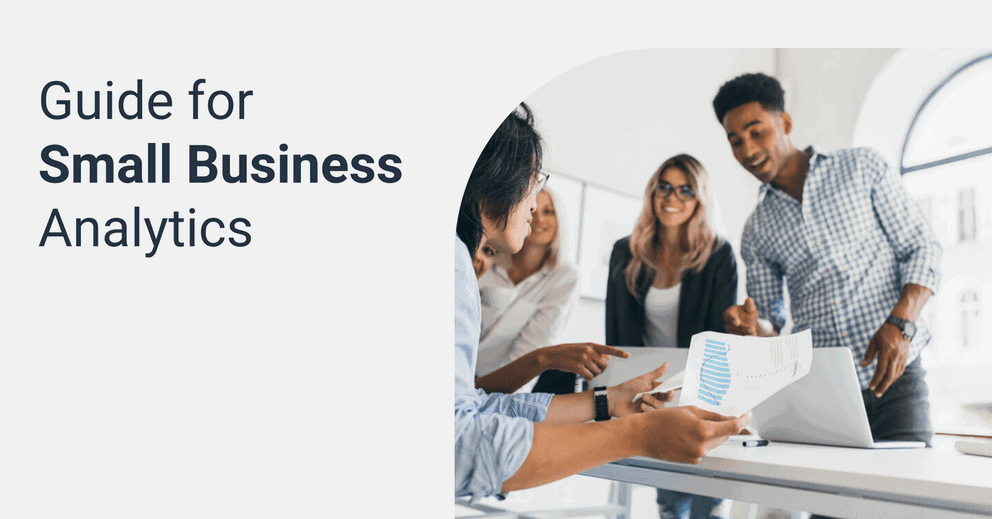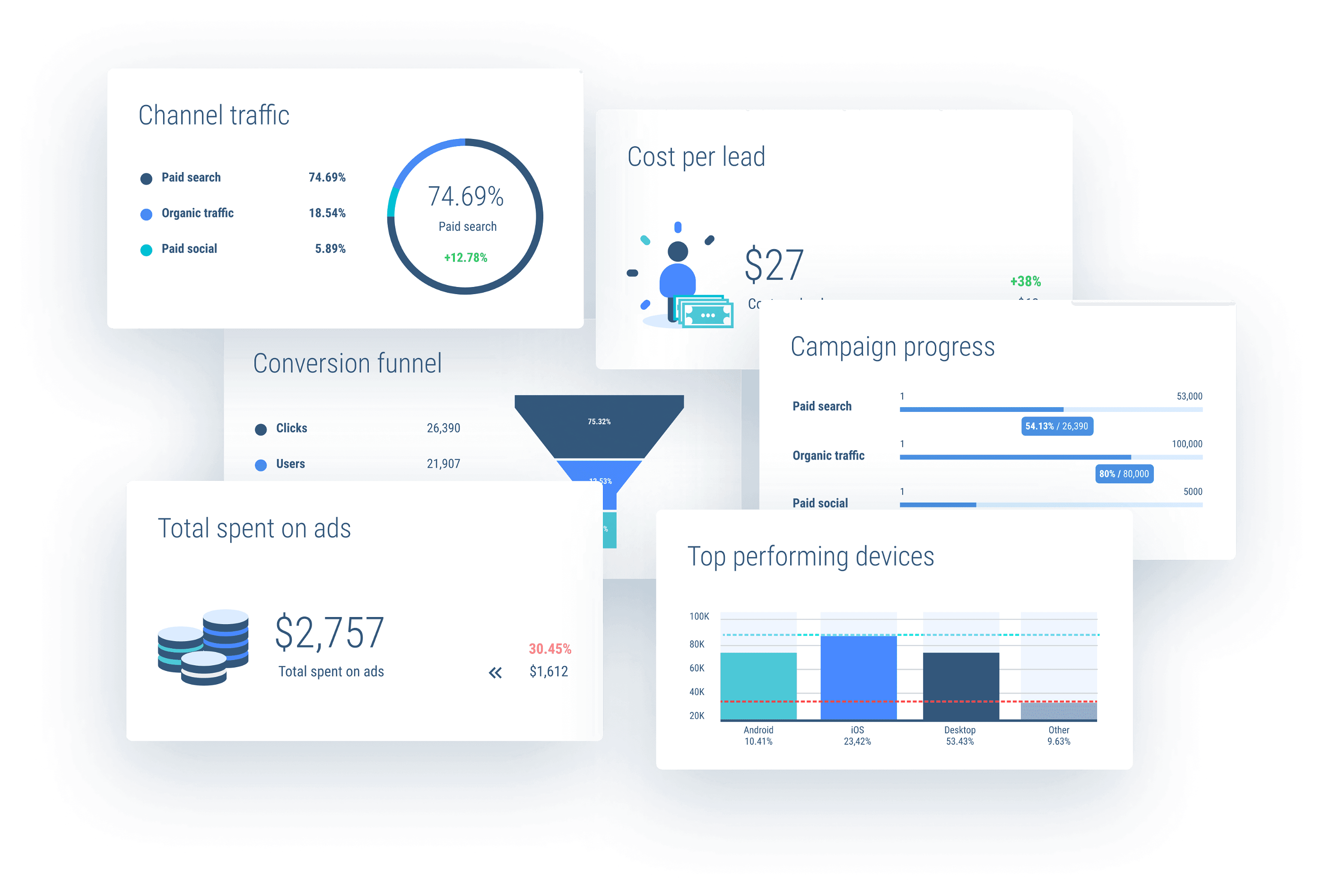What you need to know about small business analytics
It feels like data and business analytics are the only things marketers talk about anymore. And seemingly for a good reason too. But what does it all mean and what's the value in it?

Oct 14 2020 ● 4 min read

What exactly is small business analytics?
Without mincing words, business analytics is the process of using statistics and/or platforms to analyze data. This is done to gain insights into business practices and improve processes and strategies.
Business analytics is turning companies upside down, especially smaller ones. In a good way, that is.
You may be wondering what sort of data small businesses can analyze, and it's a fair question.
Primarily, they can keep track of data from email marketing campaigns, social media campaigns, website data, and much more.
With the amount of time it takes, and the bulk of data to be analyzed, the most common and seemingly best solution for small businesses is using data analytics software.
"Information is the oil of the 21st century, and analytics is the combustion engine."
- Peter Sondergaard
There are loads of analytics tools for business, but finding the right solution for small business owners is vital.
Sure, you could use Google analytics or some other platform, but it's likely not going to lead you to better decision making or make better your processes.
Why? We'll get to that shortly. But first, let's look at the case for using analytics for small businesses.
Why use business analytics?
It might seem self-explanatory, but companies use business analytics to optimize areas of work and make processes and strategy more efficient. That's because of small business analytics nails down specific actions and processes that lead to improving results that can be visualized in a small business dashboard.
According to a report published by SCORE, close to 51% of small business owners think that data analysis is necessary in order to better operations, but only 45% of them perform data analyses.
If this seems counterintuitive to you, you're right.
Business analytics can help immensely, and it is really at the forefront of peoples' minds. This is why more and more businesses are using data analysis tools like Whatagraph?
Platforms that offer actionable data and detailed performance insights can take a small business to the next level.
 |
"How so?" you might ask.
Well, take, for example, this research done by the Georgia Small Business Development Center (SBDC). The team found that businesses that use data analytics, on average, see 15% more sales than companies that don't.
Landing 15% more sales is impactful for organizations of any size, but particularly for small ones. And that's precisely why more and more businesses are on the hunt for analytics platforms that can give present data in ways they can use.
If you knew what you were doing right and what you were doing wrong, you'd likely want to make some adjustments. Right? Actionable analytics reports can enable businesses to do just that.
While many companies currently employ software platforms to report on data and get analytics, there is a pressing issue within the analytics software sector.
It's mostly a problem of communication. Well, sort of…
The problem with (most) analytics tools
Yes, most analytics tools have the capability of presenting raw data. But it's just that, raw data.
Many of the analytics tools available aren't aimed at small business data analytics. This means the information is unrefined and not easy for small business owners to understand. In turn, they are making it difficult for them to make better decisions.
A big issue is that much of the data presented includes lots of foreign numbers and little-to-no data visualization. If you want to get value from data, it has to stir you to make adjustments and changes based on the insights.
And it can't do that if you don't understand the complex data.
As a result, most complex marketing terminology and numbers get lost in the mix, and these small businesses can't do much with the unintelligible and complicated information.
The analytics should be focused on being understandable, helping identify issues, and not overwhelming. In other words, actionable for non-native marketers.
Funny enough, most analytics tools tout their ability to solve problems, yet their complexity proves them to be just another issue to solve. It inevitably leaves the incidence of small businesses.
You're probably scratching your head and wondering why this is the case.
Shouldn't there be analytical tools that are easy to understand, visual, and insightful?
Small businesses shouldn't be expected to be expert marketeers with the same know-how as a digital marketing agency, should they?
A tool for small business analytics
Thankfully, there are, in fact, tools that are geared towards helping small businesses with analytics.
This means becoming a data-driven company has never been an easier task. All you need to do is focus your efforts, allocate resources, and get the right system in place.
Speaking of the right system...Whatagraph is one of the few platforms that simplifies clustered and complicated data through visualized reporting.
 |
It grants more in-depth insights into business operations in an understandable and actionable way. This allows business owners to understand customer behavior and use data to make more informed decisions.
Not only does it score points in the visualization aspect, but it's also incredibly easy to use with its drag and drop system for cross-channel reporting.
This is the type of platform that small businesses need in order to get ahead of their growing competition within the data and business analytics sector.
At this point, you're probably wondering where to start with all of this information.
Getting the ball rolling
If you're looking to optimize processes and improve decision making as a small business, you don't want to miss out on self-service analytics.
Contrary to popular belief, it's not as simple as just gathering data and reporting on the data with tools.
It's of chief importance that the right mindset is there to complement the analytics. Becoming data-driven is an active choice from the top down. This requires that adjustments actively be made based on the analytics.
Accomplishing this feat is very doable with the right tools and objectives.
When it comes to the data available, don't just let it go to waste - use it as a way to address your needs and grow your company.
Published on Oct 14 2020

WRITTEN BY
Roberta AukstikalnyteRoberta is a content writer and editor who strives to share industry updates with her readers. Her professional background includes Public Relations and Customer Success.